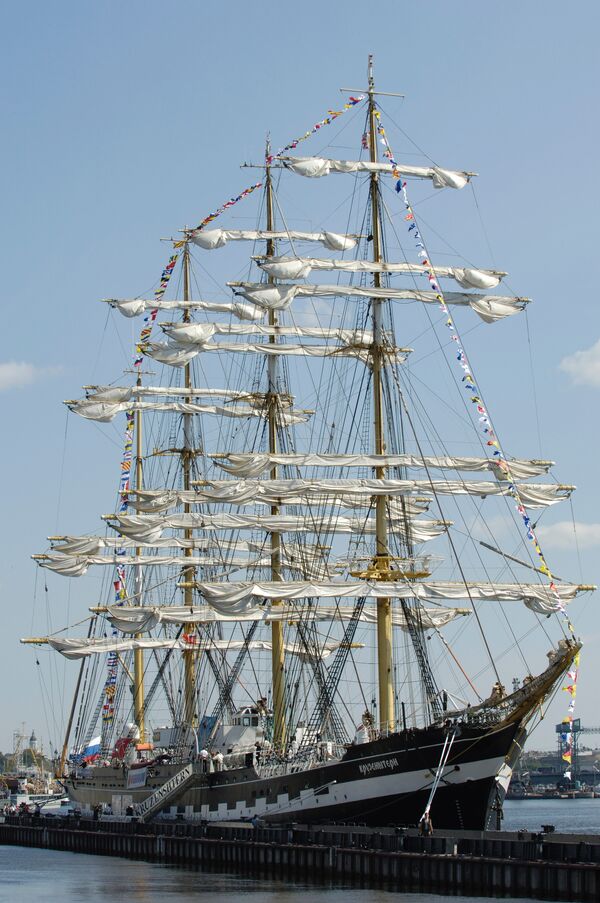Nikolai Paletsky, representative of the ship’s owner and head of the Department of Navigation and Practical Training at the Baltic Fishing Fleet State Academy (BFFSA), discusses the circumnavigation of the world by the Russian barque Kruzenshtern in this RIA Novosti interview.
- Mr. Paletsky, the second stage of the Kruzenshtern’s international trans-Atlantic expedition is now underway. Could you update us on the trip’s most recent events?
The tall ship once again crossed the Atlantic Ocean from the Canary Islands to Central America in three weeks and entered the Pacific Ocean via the Panama Canal. The crew celebrated New Year during this leg of the journey.
Classes were conducted as planned. The cadets carried out maintenance work and kept watch. Moreover, the stern rudder was manned by four-cadet teams for the first time. The cadets now really know what it is like to handle the rudder on the high seas.
We sailed the Atlantic at an average speed of 190-200 nautical miles per day. The crew was ordered on deck just a few times to adjust the rigging. They had fair trade winds, and their maximum speed under sail totaled 9.2 knots. The Kruzenshtern reached the port of Colon in Panama on schedule and there underwent preparations for its journey through the Panama Canal.
- Has the Kruzenshtern sailed through the Panama Canal before?
This was the first time the ship had sailed through the Panama Canal. The Academy administration was a little concerned that none of the Kruzenshtern’s commanding officers had prior experience of navigating the Canal. However, the crew prepared for the crossing well. Web cameras relayed online footage of the ship from the Canal’s locks direct to the Academy. The ship sailed successfully through the Canal, and did so within 10 minutes of the original timetable.
-What is the current condition of the Kruzenshtern’s foremast which was damaged by a squall last summer?
Although we started repairing the foremast in the United States, a complete overhaul was carried out at a shipyard in Kaliningrad. The crew was instructed to adjust the rigging enroute to the Canary Islands. Despite harsh weather conditions, this was virtually accomplished. Fore-topsails were hoisted during the trans-Atlantic voyage. All sails were flying as she entered the Caribbean Sea.
The tall ship which is now sailing to Vancouver will probably play an ancillary role in the Winter Olympic Games.
We feel very lucky that the crew will be in Vancouver and that they will have the opportunity to soak up the atmosphere of the Olympic Games. The crew of the Kruzenshtern will organize a variety events for the Russian national Olympic team, including Hockey Soirees, cruises and lots more. I will not say any more now because I want this to be a pleasant surprise for them. After leaving Vancouver, the Kruzenshtern will call at ports in Venezuela and Cuba and is expected to return to Kaliningrad by May 31.
-A round-the-world trip also requires substantial preparations from the ship’s owner.
You are absolutely right. The ship-owner has to keep in touch with his ship, which in this case has 80 sailors and 120 cadets on board. The ship’s technical condition, as well as the morale of crew and cadets, needs to be assessed at every port. We also organize official onboard receptions and visits by port and municipal authorities in advance. Russian diplomats and trade delegates often visit the ship because the Kruzenshtern also carries out diplomatic missions on every voyage. Before calling at a port, we have to prepare a packed program of cultural and sports events for the entire crew.
Food, water and fuel stocks must also be replenished at every port. All this requires meticulous planning because the expedition’s timetable is extremely precise and delays at ports are simply inadmissible.
-BFFSA cadets and those from other schools of the Russian State Committee on Fisheries (Rosrybolovstvo) have had their regular rotation aboard the Kruzenshtern. How important are rigging classes for future fishing-ship captains who are not likely to command tall ships?
The Kruzenshtern crossed the Atlantic under sails and using engine power and has now unfurled all her sails in the Pacific Ocean. This means that the cadets are fully aware of how to adjust the ship’s rigging.
Why do we need rigging classes? Ship crews are away from their homes and families for a long time. They often have to work in adverse and unpredictable weather conditions. As nature forgives no mistakes, raw courage, rather than mastery of equipment and theoretical prowess, becomes the most important quality for any seaman. Not a single cadet refused to climb the masts even during the most severe storms. This means they have overcome another important barrier in learning how to be fishing-fleet captains. The core crew contributes greatly to cadet training and step by step passes its professionalism on to the next generation of sailors.
-There are female cadets on board this trip, how do they find being on board, is their training and preparation program any different?
All six girls are second-year students from the BFFSA’s radio-technical department. In fact, they adapted faster than all the other cadets. Although they receive the same training as other cadets, they do not climb above ship-mast round tops when the entire crew adjusts the rigging. Nor do we use them to carry out strenuous jobs. Fortunately, there were more than enough Snow Maidens during the New Year celebrations.
The expedition continues. We are planning its final stage, and preparing for the beginning of the next trip. In June 2010, the Kruzenshtern will put to sea once again.
MOSCOW, January 26 (RIA Novosti)

